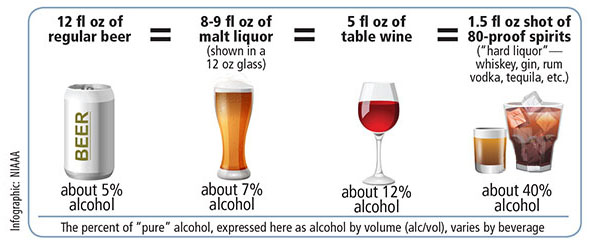Information on Alcohol Dependence
Symptoms of Alcohol Misuse
The use of alcohol doesn't always lead to alcohol abuse or dependence. The line between casual use and misuse leading to abuse or dependence is unknown, as each individual is unique and their response to use will vary. The physical, behavioral, and psychological harm from alcohol misuse varies as well, as each person can be impacted differently.
Alcohol Misuse
Alcohol misuse can be excessive or frequently drinking, binge drinking, or continued drinking regardless of any negative consequences. Repeat alcohol misuse impacts the brain and increases the risk of developing alcohol dependence.
Alcohol Dependence
Alcohol dependence is also known as alcohol use disorder. According to the National Institute on Alcohol Abuse and Alcoholism, excessive alcohol use (toxicity) damages the liver, kidneys, and other organs, including the brain, and is the third leading cause of preventable deaths in the United States.
Alcohol dependence is characterized by:
- Cravings and compulsions to drink alcohol
- Drinking to relieve or avoid withdrawal symptoms
- Physical withdrawal symptoms including nausea, headache, tremors, pain, fatigue
- Psychological withdrawal symptoms such as hallucinations deliriums, anxiety, depression, suicide ideations, harmful tendencies, etc.
- Repeat relapses after attempting to quit
- Tolerance — when the brain and body adapts and needs more alcohol to get the same effect as before
- Uncontrollable drinking despite negative consequences of harm or distress to self or others, such as arrests for drinking behaviors
Impact of Drinking Too Much
When a person drinks an alcoholic beverage, about 20% of the alcohol is absorbed in the stomach and about 80% is absorbed in the small intestine. The rate the alcohol is absorbed depends upon several factors:
- The concentration of alcohol in the drink — The larger the concentration, the faster the absorption.
- The type of drink — carbonated drinks tend to speed up absorption of alcohol.
- Whether the stomach is full or empty — Food can slow down alcohol absorption.
Alcohol's immediate effects can be noticed within 10 minutes of drinking. Continued drinking increases the blood alcohol concentration (BAC) level, which is the amount of alcohol present in the bloodstream. The higher the BAC, the more impaired one becomes from further alcohol consumption.
The effects of drinking alcohol in excess may include:
- Reduced inhibition
- Slurred speech
- Concentration and memory problems
- Confusion
- Motor impairment
- Breathing problems
- Coma
- Death
- Accidents, including car crashes
- Dangerous or risky behavior
- Violent behavior, including fighting
- Suicide and homicide
A Standard Drink
Surprisingly, many people are unaware of what counts as a standard drink. The quantity of liquid in one's glass, can, or bottle does not necessarily indicate how much alcohol one actually drinks. Beer, wine, and malt liquor vary in alcohol content. For example, many light beers have almost as much alcohol as regular beer — about 85% as much. It is important to know how much alcohol a drink contains. Beer examples are:
- Regular beer: 5% alcohol content
- Light beer: 4.2% alcohol content
- 12 ounces of regular beer — about 5% alcohol
- 5 ounces of wine — about 12% alcohol
- 1.5 ounces of distilled spirits — about 40% alcohol
Although the "standard" drink sizes are helpful for following health guidelines, they may not reflect customary serving sizes. For example, a single mixed drink made with hard liquor contains the equivalent of 1 to 3 or even more "standard" drinks. The type of spirit, recipe, and size of serving glass can impact the quantity of hard liquor in the drink.



